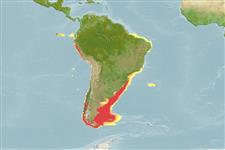Common names from other countries
Classification / Names / Names
Nomi Comuni | Sinonimi | Catalog of Fishes (gen., sp.) | ITIS | CoL | WoRMS
Environment: milieu / climate zone / depth range / distribution range
Ecologia
Batidemersale. Subtropical; 0°N - 90°S, 180°W - 180°E
Eastern Pacific and Southwest Atlantic: Arctocephalus australis gracilis: Peru, southern Brazil, Uruguay, Argentina, Chile (Ref. 1394, 1522); vagrant to Colombia and Juan Fernandez Islands (Ref. 1522); Arctocephalus australis australis: Falkland Islands (Ref. 1522). Tropical to temperate climates.
Length at first maturity / Size / Peso / Age
Maturity: Lm ? range ? - ? cm Max length : 190 cm TL maschio/sesso non determinato; (Ref. 1394); 140 cm TL (female); Peso massimo pubblicato: 200.0 kg (Ref. 1394); Peso massimo pubblicato: 200.0 kg
Inhabits primarily coastal, continental shelf and slope waters; and there are records from more than 600 km offshore. Feeds on small schooling fish and invertebrates such as cephalopods, crustaceans and gastropods. Found primarily coastal, continental shelf and slope waters; there are records from more than 600 km offshore. Feeds on small schooling fish and invertebrates such as cephalopods, crustaceans and gastropods (Ref. 1394).
Life cycle and mating behavior
Maturità | Riproduzione | Deposizione | Uova | Fecundity | Larve
Pups are born in dense breeding colonies. Perinatal attendance averages one week, then mothers forage offshore several days at a time. Upon arrival from sea, mother and pup reunites using vocalization signals and olfactory cues, i.e., naso-nasal contact. Lactation lasts at least 12 months.
Jefferson, T.A., S. Leatherwood and M.A. Webber. 1993. (Ref. 1394)
IUCN Red List Status (Ref. 130435)
CITES status (Ref. 108899)
Human uses
Pesca: commerciale
FAO - pesca: landings, species profile | FishSource | Sea Around Us
Strumenti
Fonti Internet
Estimates based on models
Preferred temperature
(Ref.
115969): 5.6 - 15.5, mean 9.2 (based on 1202 cells).
Resilienza
Medio, tempo minimo di raddoppiamento della popolazione 1.4 - 4.4 anni (K=0.3).
Vulnerability
Moderate to high vulnerability (52 of 100).
Price category
Unknown.
